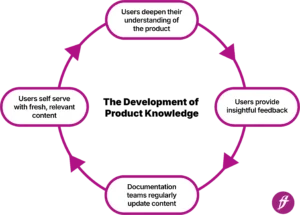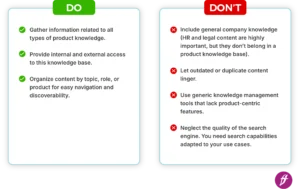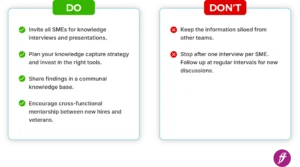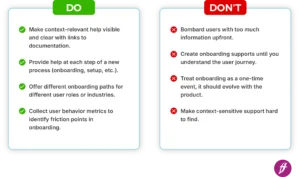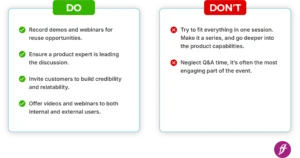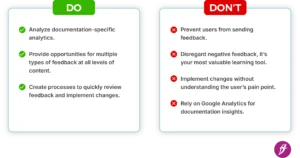Clear, detailed, accurate product knowledge is a key part of successful operations in a company. This mission-critical information provides extensive benefits across teams and creates value for end-users. It’s clear this is a resource worth investing in. After all, the International Data Corporation reported that poor knowledge-sharing practices cost Fortune 500 companies about $31.5 billion annually.
What strategies are companies using to enhance their technical content for deeper product understanding across user groups? Below, we break down six core strategies along with the “do’s and don’ts” highlighting best practices for each.
Why Developing Product Knowledge is a Priority
First, let’s agree on what we mean by “product knowledge”. In this article, we’ll refer to developing product knowledge in two ways:
- Deepening internal and external users’ understanding of the product
- Optimizing or updating the product information available
These two facets of product knowledge form a positive feedback loop as better knowledge content leads to an optimized product understanding. At the same time, this improved comprehension generates more insightful feedback, which in turn helps refine and update the content.
Companies gain value from developing product knowledge as it enhances innovation, accuracy, and credibility across teams, from sales to customer support and field service operations.
In sales, product knowledge helps representatives clearly communicate value, handle objections, and tailor solutions to customer needs, resulting in higher conversion rates. It enables customer support teams to resolve issues faster and more accurately, which improves satisfaction and reduces repeat inquiries. For field service teams, these insights allow technicians to diagnose and fix problems quickly, minimizing downtime and the need for repeat visits.
In every case, better product knowledge leads to more confident teams and stronger customer experiences.
First, Secure These Product Content Prerequisites
Before we can discuss how to deepen product knowledge, we need to talk about content. After all, with Shelf’s report stating that 94% of company files have at least one inaccuracy, 26% are out-of-date, and 33% have partial duplication, organizations have some work to do.
There are two core content prerequisites for maximizing product knowledge.
Enhance Your Content Quality
The first is to secure a high level of quality writing. While technical writers are preparing product content, they must ensure all documentation consistently meets the high standards set out by their team. This includes the need to collaborate with various experts including product managers, engineers, and support teams to develop documentation that reflects the true product capabilities and real user scenarios. During editing, they must also eliminate any issues related to clarity, tone of voice, terminology, or compliance with style guides. Tools like Acrolinx, oXygen Positron AI Assistant, and Congree UCC can help.
Optimize Your Content Structure
Equally important as quality writing is the structure of the content itself. Not only is structured content critical to efficiently create extensive product knowledge, but it also facilitates content reuse and the creation of custom variants. Moreover, it improves the usability of content: metadata and taxonomies make it easier for search engines and user applications to find the right content for a given context and dynamically deliver it to each user’s device. As a result, users enjoy personalized and intelligent product content experiences.
Plus, as organizations increasingly invest in AI-powered experiences, these content prerequisites become even more critical, since the effectiveness of AI outcomes directly depends on the quality and structure of the underlying content.
6 Strategies to Develop Product Knowledge
There are multiple ways to enhance product understanding and optimize product documentation. Let’s look at six of the top strategies that strengthen this feedback loop.
1. Build a Product Knowledge Base
A product knowledge base is a digital library that gathers and organizes documentation related to all types of product knowledge. This includes market, technical, functional, and practical hands-on knowledge which are each found in different formats and used by different teams. Since this information is typically scattered across content sources, a product knowledge base serves as a place where companies can centralize all product documentation.
Crucially, this turns the knowledge base into a single source of truth that allows internal and external users to easily access information and improve their product understanding. With 91% of customers reporting that they would use a digital knowledge base if it were available and met their needs, this is a key resource to invest in. Companies can further enhance how easy it is for users to find product knowledge with functionalities such as a user-friendly interface and advanced search functionalities.
2. Upgrade Employee Training
A thorough training program needs to be a priority for companies. The program should include detailed videos, documents, and tests that extensively cover product knowledge for all types of learners. By creating comprehensive and varied training plans that start at onboarding, companies build a strong product knowledge foundation.
Beyond an employee’s first few weeks or months, companies can extend training opportunities by offering internal mentoring and upskilling programs with in-house product experts. This is a valuable way to help new and existing employees become true product experts.
Finally, companies should provide funding for external training opportunities like workshops, certifications, and conferences. These events ensure teams stay up to date on the latest industry best practices.
Learning opportunities are essential as well-trained employees are more confident in their roles and decisions, tend to make fewer mistakes, and offer a better customer experience. These qualities lead to higher company credibility and user trust.
3. Engage in Subject Matter Expert Discussions to Capture Tacit Knowledge
Subject matter experts (SMEs) have extensive implicit knowledge gained over the course of years of diverse product experiences. However, this experiential knowledge is often not formally documented. This becomes a huge problem when people change jobs and take their tacit knowledge with them, leaving a gap in the company’s internal product expertise. To combat this while helping others reach the same, nuanced level of understanding, companies need to capture this information and make it available for use.
Organizations will need to invest in the right kind of documentation tools and create knowledge sharing processes to formalize this information as written content. Teams should also encourage SMEs to give internal presentations and participate in Q&A sessions with different teams including sales, customer support and success, marketing, and more. These discussions provide opportunities for experts to spread knowledge, share unique experiences, and respond to questions.
4. Facilitate User Onboarding
Over 90% of customers agree that the companies they purchase from “could do better” regarding their onboarding for new users. There are many supports that companies can implement to improve their onboarding, from in-product guidance to welcome emails, interactive tutorials, and of course, access to a knowledge base for self-service support.
These personalized and contextualized support elements ensure users receive pertinent information when and where they need it directly within their onboarding workflows.
Sharing easy-to-access product knowledge during onboarding also helps users take ownership of becoming product experts. This is key as 55% of people report having returned items or cancelling licenses because they didn’t fully understand how to use the product. Conversely, integrating information and resources throughout user onboarding fosters autonomy and reduces support costs.
5. Provide Product Demos and Webinars
Everyone has different learning styles, so companies shouldn’t simply rely on written documentation to develop user product understanding. A hands-on way to help external users enhance their product knowledge is to set up videos and webinars that showcase precise product information, explore use cases, and walk attendees through feature demos. Ideally, companies should offer live sessions that allow time for question-and-answer sessions where users can get insights into common pain points.
When companies build a dedicated strategy around distributing product knowledge via video and live events, the result is an enhanced understanding of product nuances, higher sales, and better user adoption rates.
6. Use Analytics and Customer Feedback
It’s impossible to update and enhance your product documentation without measuring how it serves users. Yet, 55.2% of companies don’t track any internal documentation metrics, completely missing out on insights into their content freshness and relevance.
Dedicated documentation analytics provide what companies need to monitor content usage, interactions, user engagement, and trends so they can assess the effectiveness of their product content and measure ROI. Then, the results can inform the roadmap and priorities of documentation teams to help them optimize the product knowledge available to internal and external users.
In addition to content metrics, customer feedback is another valuable resource to improve product content. Receiving feedback is a rare opportunity for direct communication between users and documentation teams. Customers are a great resource for flagging unclear, outdated, scattered, or missing content, and they often provide concrete examples of how to improve it. To harness this opportunity, companies should provide the ability to give different types of feedback at both the topic and documentation levels. Then, any feedback should go straight to the documentation team so they can implement changes and updates quickly.
The Future of Product Knowledge
Throughout your efforts to deepen product knowledge, it’s important to note that this is not a one-time initiative. Products evolve and the documentation surrounding them does too. Developing product content is a continuous process that applies to every corner of an organization, so it must be a collaborative process.
Right now, most knowledge is created by the company for internal and external users. The six strategies outlined above are crucial for developing product knowledge, but in the near future we will see a seventh strategy emerge.
External users have specific knowledge thanks to their hands-on experience using a product, but it either stays in their heads or is used to make user-generated content that doesn’t go through the same content quality checks and preparation as official documentation. Companies will need to capture this user knowledge, simultaneously putting the necessary control and validation systems in place to ensure shared content meets the expected quality and accuracy. As we head towards this new opportunity, product documentation spaces will become more open to collaboration, allowing for a seamless knowledge exchange.
Latest post

